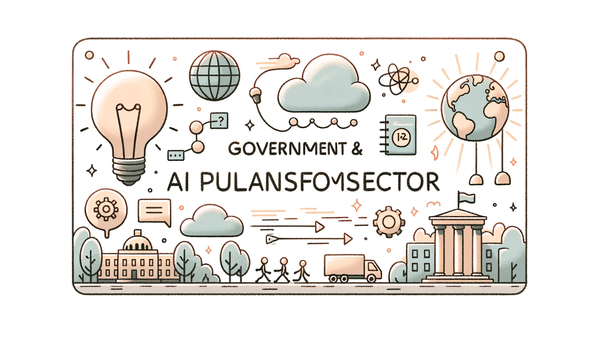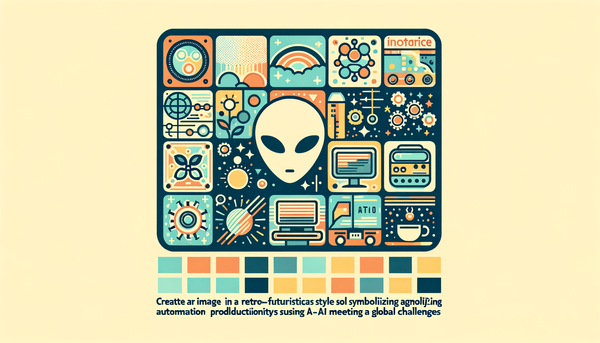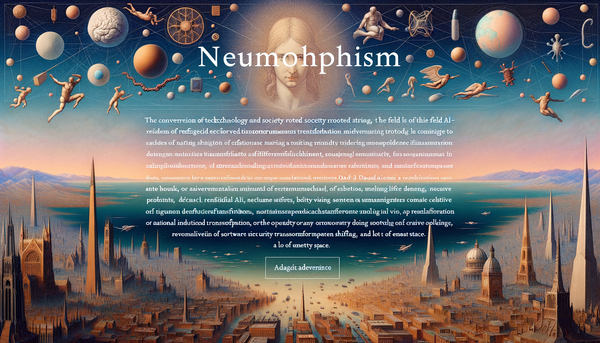LaunchDarkly's Dance with AI in Product Management
When I first witnessed how a seemingly modest tweak like the Chain of Draft approach slashed resource usage in complex AI tasks, it reminded me that innovation often sprouts from the simplest of insights—an insight that now echoes across boardrooms, product labs, and even the GitHub pages of tech enthusiasts.
Simplifying Complexity: The Promise of Efficient AI Models
In the recent discourse on AI methodology, a breakthrough has emerged: the Chain of Draft approach. This method empowers AI models to execute tasks with substantially fewer resources, thereby addressing one of the most persistent challenges in deep learning—high computational costs. By efficiently breaking down tasks into manageable subtle "drafts" or segments, AI systems can iterate toward better solutions without bloating resource requirements. While the technical details remain complex, the core idea resonates with an old engineering principle: work smarter, not harder.
Engineers have often alluded to this method as akin to "thinking out loud" and refining ideas on the fly, albeit in a digital manner. One could compare it to a writer drafting an article in successive versions until clarity is achieved. This sort of iterative refinement in AI is exciting given the challenges of scale and energy consumption. As
Andrew Ng once stated, "Artificial intelligence is the new electricity,"
the inspiration remains to harness these innovations, rendering AI both more efficient and environmentally sustainable.
The potential of such methods resonates broadly in an era where AI resources are being increasingly optimized for both performance and ecological footprint. This perspective is also mirrored across several recent developments shared on platforms like NetActuate Launches Coherently AI, which highlights the convergence of scalability and sustainability in AI infrastructure.
Tech Giants and Unanticipated AI Moves
The stage of innovation is not solely populated by traditional breakthroughs in algorithmic efficiency. In a startling move, Apple—known for its revered product streak—found itself breaking ranks while unveiling an unexpectedly misplaced device in the AI arena. By introducing an AI product aligned with a device that appeared to be out of sync with consumer expectations, Apple inadvertently challenged conventional product paradigms. Some might argue that this misalignment is a hint that sometimes bold risks can lead to serendipitous futures in technology.
Meanwhile, over at Ars Technica, attention has shifted to Google’s innovative Pixel Sense app. This AI-powered tool is designed to harness the immense data collected by Pixel 10 devices, potentially revolutionising how personal data is used for enhanced user experiences. While privacy concerns remain a hot topic, the underlying innovation cannot be dismissed. Google’s initiative signals how AI is straddling the fine line between providing personalized services and managing the ethical implications of data usage.
One cannot help but recall Satya Nadella's uplifting remark:
"AI represents a way to unlock human potential. It allows people to focus on innovation and creativity, while machines take care of repetitive tasks."
Such statements serve to remind us that both necessity and ambition are vital ingredients in the evolution of technology—especially within disruptive companies like Apple and Google.
These technological experiments are parallel to the themes explored on Amazon Enhances Loyalty with Alexa AI, wherein customer relationship dynamics are being reinvented with AI-powered systems. While the focus there is on retail and customer engagement, both initiatives underscore a broader industry shift that places AI at the core of strategic innovations.
Integrating AI in Product Management and Government
Another intriguing facet of the current AI narrative hails from the intersection of product management and government innovation. For instance, a series of GitHub posts by a DOGE staffer have given glimpses into Elon Musk’s vision for integrating AI into public-sector governance. According to these posts, the goal is not only efficiency but also transparency and a level of automation that could redefine public decision-making processes. Such initiatives suggest that AI might soon become as integral to government operations as it is to consumer technology.
Complementing this governmental perspective, LaunchDarkly's AI-powered product management approach has emerged as a testament to the power of AI in driving product strategy and execution. This approach leverages data optimizations and predictive analytics to aid decision-makers in launching products that align closely with market expectations. The methodology could soon become standard practice across tech companies aiming to reduce guesswork while bolstering customer satisfaction.
Such blending of product management and government functions follows a broader trend where AI is incrementally dissolving conventional boundaries between sectors. This holistic integration is reminiscent of the evolution witnessed in other areas—where strategies for controlled innovation are replicated almost like best practices across industries.
Moreover, this sort of cross-sector innovation is a recurrent theme on platforms exploring AI Trends Transforming Industries. We see that the drive to implement AI for large-scale productivity improvements is as much an ethical and strategic decision as it is a technical upgrade. The ongoing emphasis on integrating AI responsibly adds a layer of scrutiny that aims to balance ambition with accountability.
Entertainment and the AI Paradox in Gaming
Amid all these technological advancements, there is also an interesting debate brewing in the realm of entertainment. One provocative assertion—"if Guitar Hero needs to use AI to exist, it shouldn't exist at all"—challenges the idea that over-reliance on technology might dilute the essence of creative pursuits. This perspective, highlighted in a recent article on TheGamer, forces us to question: When does technology enhance creativity, and when does it compromise the raw human elements of art and play?
In our daily lives, the balance between automation and authenticity is a theme that continues to prompt vigorous discussions. For instance, while AI in product management and government is celebrated for increasing efficiency, the incursion of AI into the core of gaming and pop culture may not always be met with the same enthusiasm. There is an inherent paradox in allowing technology to recreate art forms that were celebrated precisely for their analog imperfections.
Historically, similar debates accompanied the introduction of synthesizers in music—a tool that was both praised for creative expression and criticized for potentially replacing live instrumentation. Many fans and critics observed that while technological enhancements can broaden creative horizons, they should not completely overshadow the human touch that gives art its soul.
This nuanced challenge of AI in entertainment invites broader introspection about the role of technology in domains that were once considered inviolable sanctuaries of human expression. The conversation also parallels debates on consumer innovation platforms, similar to those documented amidst the rapid advancements in the field of consumer AI.
Innovation, Investment, and the Rise of AI Startups
No discussion about AI’s expanding influence would be complete without acknowledging the vigorous investment landscape that now surrounds it. In a striking demonstration of faith in the technology's future, the Google-backed IT startup NinjaOne recently raised a staggering $500 million. This confidence from major players not only reinforces the potential of startups in the AI ecosystem but also highlights the ever-blurring lines between technology, business, and venture capitalism.
The infusion of substantial capital into AI startups signals a confidence that innovation will continue at a rapid pace, perhaps even accelerating more than ever before. By streamlining product management through robust AI frameworks and creating applications that capture enormous amounts of data—such as Google’s AI-powered Pixel Sense—the industry is witnessing what could be termed a golden age of AI-enabled business transformation.
Such developments remind investors and enthusiasts alike of the continuous need for creativity and realism. Satya Nadella's earlier sentiment—that AI unlocks human creativity—is especially applicable here. It is the relentless combination of investment and innovative thought that continually redefines what is feasible. Cross-referencing insights from the NetActuate’s new AI infrastructure allows us a glimpse into a future where dynamic, scalable solutions are the norm rather than the exception.
The rising tide of AI startups not only consolidates digital innovation but also points to a burgeoning ecosystem where traditional industries and new ventures intersect. It is a realm where public and private sectors can benefit mutually from each other's ventures into smarter, more cost-effective applications.
Ethics, Opportunities, and the Road Ahead
As we marvel at these technological feats—from innovative methods that drastically reduce resource use to provocative leaps in consumer technology—the conversation increasingly centers on the ethical implications and pathways for future development. The blend of risk and opportunity in AI is a recurring motif, exemplified by the multifaceted discussions about AI in government, product management, and even playful cultural touchstones like video games.
The rapid pace of change demands rigorous ethical frameworks and transparent policies. Recent insights shared on The Future of AI: Challenges, Innovations, and Ethical Dilemmas underscore the importance of balancing progress with responsibility. As innovators push the boundaries of what machines can do, they simultaneously need to navigate uncharted ethical waters—a task that has never been more urgent.
There is also a growing consensus that fostering trust and accountability in AI will be crucial to its broad acceptance. This involves not only technical safeguards and regulatory compliance but also ensuring that the human element remains at the forefront of decision-making processes. In my view, the journey of AI development mirrors a constant dialogue between potential and practicality, between unbridled innovation and the prudent oversight necessary to benefit society.
Drawing inspiration from Fei-Fei Li’s observation that "AI will impact every industry on Earth, including manufacturing, agriculture, health care, and more," we find ourselves at a crossroads detailed by both bold experiments and cautious optimism. The challenge lies not in the capability of AI but in the determination to deploy it judiciously.
Alongside incorporating emergent techniques like the Chain of Draft method, companies and startups alike are embracing the need for agile yet responsible innovation. The stories of companies such as Apple, Google, and NinjaOne remind us that while the allure of technological advancement is irresistible, anchoring these achievements in robust frameworks of ethics and transparency is ultimately what will define success in this new era.
Reflecting on the Future
It is an exciting time to witness how AI is reshaping industries and the very essence of how we interact with technology. From dramatically lowering computational overheads with pioneering methods, to integrating into everyday devices and public administration, the landscape is evolving at an unprecedented pace. Each venture—from the unexpected missteps in product launches to the highly strategic moves in government integration—provides vital insights into the future trajectory of artificial intelligence.
As I reflect on these developments, the prevailing sentiment is clear: innovation must be married with foresight. The blend of technological audacity and ethical diligence that defines today's AI projects promises a future where machines not only emulate human capabilities but also enhance our quality of life in responsible ways.
In many respects, AI today is much like a grand experiment seen throughout history—filled with trial and error, moments of brilliance, and the occasional stumble. Yet, every step forward brings us closer to a more interconnected and efficient world, where the potential of human creativity is amplified rather than diminished.
In conclusion, the corridor of AI innovation is lined with both dazzling breakthroughs and debates on the essence of progress. Whether it’s through managing data more efficiently, redefining customer engagement, or boldly entering territories like government and gaming, such advances continue to challenge our perceptions and expectations. The stories lined up here not only attest to the relentless drive behind AI development but also pave the way for the next chapter in this captivating journey.




